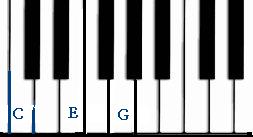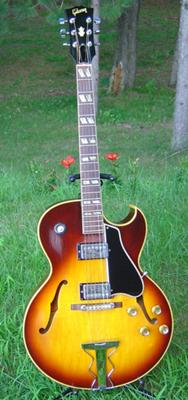Piano Chord Inversions
"Piano Chord Inversions"
What ARE chord inversions? The term "chord inversion" refers to changing the order of the notes in a chord. There are as many positions of a chord as there are notes in the chord. That is, a triad has 3 positions, a dominant 7 chord has 4 positions, etc.
When the name of the chord is the lowest note, it is called "root position". Root position triads are probably the easiest to learn and should be mastered in all 12 keys before you branch out into chord inversions.
For example: a C Major chord:

A First Inversion chord is formed when the 3rd of the chord is
the lowest note. For example, a First Inversion C Major chord is spelled
E G C. A First Inversion C Dominant 7 chord is spelled E G Bb C.

First Inversion: E G C
Chords in the Second Inversion have as their lowest note the 5th
of the chord. A C Major triad in Second Inversion would be spelled G C
E. A second Inversion Dominant 7 chord is spelled G Bb C E.

Second Inversion: G C E
Do you wish you could learn songs faster? Would you like to be able to
play a song just by HEARING it? The program that I use to help my
students is called "Pure Pitch". To learn more about this exciting program, Click Here! (opens in a new window)
How to use Piano Chord Inversions:
USES OF CHORD INVERSIONS
There are several reasons to invert chords. One is to make the transition between chords smoother. A chord progression played with root position chords ONLY tends to be jumpy and difficult to play.
Another reason to use piano chord inversions is to make a smoother sounding bass line. The use if First inversion chords also allows the bass line (where the left hand plays single note roots) and the chords to move in opposite directions, which often is more desirable than parallel motion.
When accompanying a vocalist, it is often useful to play the melody note as the highest note in the chord in order to add support to the vocalist's melody.
Another important use for chord inversions is to devise "chord melodies" in the right hand. In playing a chord melody, you use an inversion of the chord so that the melody note is the highest note in the chord. This produces a melody that is already harmonized in the right hand, leaving the left hand free to develop an interesting bass line. This is a common practice among jazz players.
Learning To Use Piano Chord Inversions
First, you must become totally familiar with the inversions of each chord. These can be practiced by playing the root position, first inversion and second inversions in order and then going back down in reverse order. Here are the fingerings:
Right Hand--135, 125, 135 Left Hand--531, 531, 521
After you have become familiar with the inversions, you can practice using them in this manner:
Play the first chord in your progression. Then determine which notes you need to play the second chord. If any of these notes are in the first chord, keep them and substitute the rest of the notes to make the second chord.
For Example: Moving from C Major to E Minor:
Keep the E and the G and change the C to B. This gives you a second-inversion E minor chord. Continue this process throughout the chord progression. The result will be that you will be able to play the entire progression with a minimum of hand position changes. Please be patient--it takes time to learn to be comfortable using piano-chord-inversions.
Take your piano playing to the next level!
Are you a beginner and just want to learn to play piano as quickly and easily as possible? Or do you already play but want to play like the professionals? This is the best affordable piano course that I have found. Plus you get access to TONS of videos and FREE sheet music! Here is what one of my visitors says about the program--"The text, along with the video and audio are outstanding. It's so easy to follow!!"Take a minute to see for yourself.
If you still have questions, please ask them at Ask Piano Questions.
It is FREE and the answer will appear as a web page within 1 day. You
can even choose to be notified when your question and the answer have
been published!
RELATED LINKS on THIS SITE
Free Printable Piano Chords Charts
Leave "Piano Chord Inversions" and Go To "Online Keyboard Lessons"
Leave "Piano Chord Inversions" and Go To "Absolutely Free Music Lessons"





New! Comments
We welcome your comments and ideas! Leave a comment in the box below.